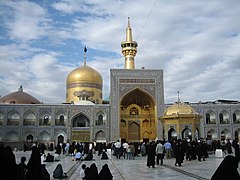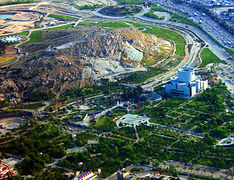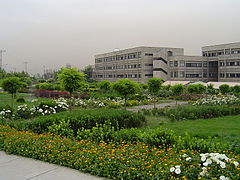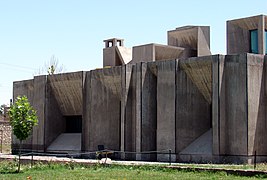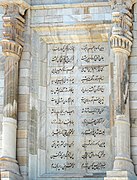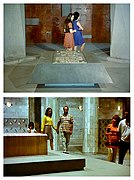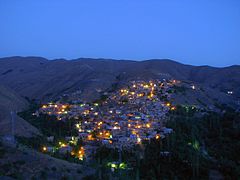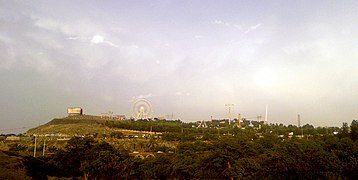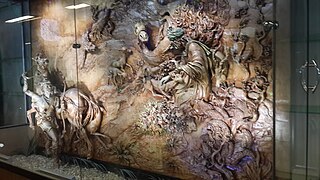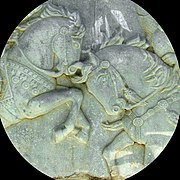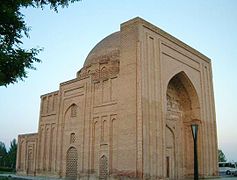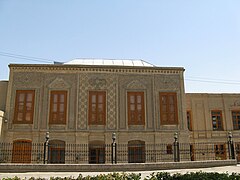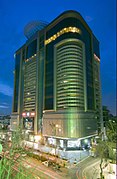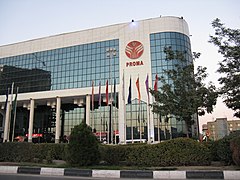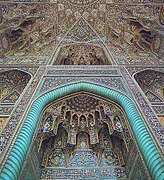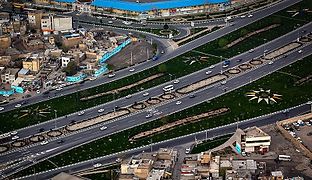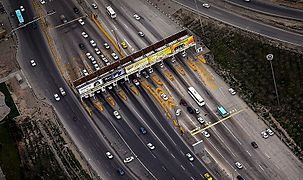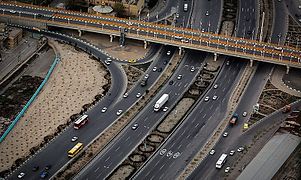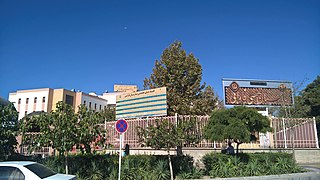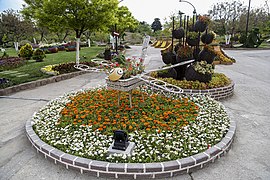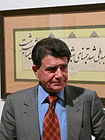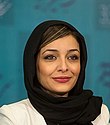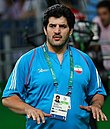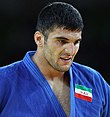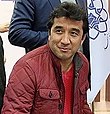Mashhad
Mashhad
مشهد ( Imam Reza Shrine ; Imam Hossein square; and Mashhad at night. | |
|---|---|
|
BSk | |
| Largest district by area | District 9 (64 km2, land area) |
| Largest district by population | District 2 (480,000) |
| Website | www.mashhad.ir |
Mashhad
The city was governed by different ethnic groups over the course of its history. Mashhad was previously a small village, which by the 9th century had been known as Sanabad, and which was located—along with
Mashhad later also became associated with Ferdowsi, the Persian poet and author of the Shahnameh, who was born in Tus (with many institutions in Mashhad named after him). Mashhad enjoyed relative prosperity in the Mongol period, and continued to grow. Between 1736 and 1796, Mashhad became the capital of Afsharid Iran which was ruled by the Afsharid dynasty founded by Nader Shah, whose tomb is located in the city. In the modern era, Mashhad continued to expand and became the hometown of some of the most significant literary figures and artists of modern Iran, such as the poet Mehdi Akhavan-Sales, and the traditional Iranian singer and composer Mohammad-Reza Shajarian. On 30 October 2009 (the anniversary of Imam Reza's martyrdom), Iran's then-President Mahmoud Ahmadinejad declared Mashhad to be "Iran's spiritual capital".[15][16]
History
Etymology and early history
Ancient Greek sources mention the passage and residence of
Also in the
The older name of Mashhad is Sanabad (سناباد Sanâbâd). It was eventually renamed to Mashhad during the
The ancient
At the beginning of the 9th century (3rd century AH), Mashhad was a small city called Sanabad, which was situated 24 kilometres (15 miles) away from
Mongolian invasion: Ilkhanates
Although some believe that after this event, the city was called Mashhad al-Ridha (the place of martyrdom of al-Ridha), it seems that Mashhad, as a place-name, first appears in al-Maqdisi, i.e., in the last third of the 10th century. About the middle of the 14th century, the traveller Ibn Battuta uses the expression "town of Mashhad al-Rida". Towards the end of the Middle Ages, the name Nuqan, which is still found on coins in the first half of the 14th century under the
Timurid Empire

It seems that the importance of Sanabad-Mashhad continually increased with the growing fame of its sanctuary and the decline of Tus, which received its death-blow in 1389 from Miran Shah, a son of Timur. When the Mongol noble who governed the place rebelled and attempted to make himself independent, Miran Shah was sent against him by his father. Tus was stormed after a siege of several months, sacked and left a heap of ruins; 10,000 inhabitants were massacred. Those who escaped the holocaust settled in the shelter of the 'Alid sanctuary. Tus was henceforth abandoned and Mashhad took its place as the capital of the district.[citation needed]
Later on, during the reign of the
Safavid dynasty
Afsharid dynasty
Mashad saw its greatest glory under Nader Shah, ruler of Iran from 1736 to 1747, and also a great benefactor of the shrine of Imam Reza, who made the city his capital. Nearly the whole eastern part of the kingdom of Nadir Shah passed to foreign rulers in this period of Persian impotence under the rule of the vigorous Ahmad Shah Durrani of the Afghan Durrani Empire. Ahmad defeated the Persians and took Mashhad after an eight-month siege in 1753. Ahmad Shah and his successor Timur Shah left Shah Rukh in possession of Khurasan as their vassal, making Khurasan a kind of buffer state between them and Persia. As the city's real rulers, however, both these Durrani rulers struck coins in Mashhad. Otherwise, the reign of the blind Shah Rukh, which with repeated short interruptions lasted for nearly half a century, passed without any events of special note. It was only after the death of Timur Shah (1792) that Agha Mohammad Khan Qajar, the founder of the Qajar dynasty, succeeded in taking Shah Rukh's domains and putting him to death in 1795, thus ending the separation of Khurasan from the rest of Persia.
Qajar dynasty

Some believe that Mashhad was ruled by
1912 Imam Reza shrine bombardment
In 1911 Yusuf Khan of Herat was declared independent in Mashhad as Muhammad Ali Shah and brought together a large group of
Pahlavi dynasty
Modernization under Reza Shah

The modern development of the city accelerated under Reza Shah (1925-1941). Shah Reza Hospital (currently Imam Reza Hospital, affiliated with the Basij organization) was founded in 1934; the sugar factory of Abkuh in 1935; and the Mashhad University of Medical Sciences in 1939. The city's first power station was installed in 1936, and in 1939, the first urban transport service began with two buses. In this year the first population census was performed, with a result of 76,471 inhabitants.[42]
1935 Imam Reza shrine rebellion
In 1935, a backlash against the modernizing, anti-religious policies of Reza Shah erupted in the Mashhad shrine. Responding to a cleric who denounced the Shah's heretical innovations, corruption, and heavy consumer taxes, many bazaars and villagers took refuge in the shrine, chanted slogans such as "The Shah is a new Yazid." For four days local police and army refused to violate the shrine and the standoff was ended when troops from Azerbaijan arrived and broke into the shrine,[43] killing dozens and injuring hundreds, and marking a final rupture between Shi'ite clergy and the Shah.[44] According to some Mashhadi historians, the Goharshad Mosque uprising, which took place in 1935, is an uprising against Reza Shah's decree banning all veils (headscarf and chador) on 8 January 1936.[citation needed]
1941–1979 reforms

Mashhad experienced population growth after the Anglo-Soviet invasion of Iran in 1941 because of relative insecurity in rural areas, the 1948 drought, and the establishment of Mashhad University in 1949. At the same time, public transport vehicles increased to 77 buses and 200 taxis and the railway link with the capital, Tehran, was established in 1957. The 1956 census reflected a population of 241,989 people. The increase in population continued in the following years thanks to the increase in Iranian oil revenues, the decline of the feudal social model, the agrarian reform of 1963, the founding of the city's airport, the creation of new factories and the development of the health system. In 1966, the population reached 409,616 inhabitants, and 667,770 in 1976. The extension of the city was expanded from 16 to 33 square kilometres (170,000,000 to 360,000,000 square feet).
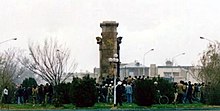


In 1965 an important urban renewal development project for the surroundings of the shrine of Imam Reza was proposed by the Iranian architect and urban designer Dariush Borbor to replace the dilapidated slum conditions which surrounded the historic monuments. The project was officially approved in 1968. In 1977 the surrounding areas were demolished to make way for the implementation of this project. To relocate the demolished businesses, a new bazaar was designed and constructed in Meydan-e Ab square (in Persian, "میدان آب")[42] by Dariush Borbor. After the revolution, the urban renewal project was abandoned.
1994 Imam Reza shrine bombing
On 20 June 1994, a bomb exploded in a prayer hall of the
Mashhad after the Revolution
In 1998 and 2003 there were student disturbances after the same events in Tehran.
Geography
The city is located at 36.20º North latitude and 59.35º East longitude, in the valley of the Kashafrud River near Turkmenistan, between the two mountain ranges of Binalood and Hezar Masjed Mountains. The city benefits from the proximity of the mountains, having cool winters, pleasant springs, and mild summers.[citation needed] It is only about 250 km (160 mi) from Ashgabat, Turkmenistan.
The city is the administrative center of Mashhad County (or the Shahrestan of Mashhad) as well as the somewhat smaller district (Bakhsh) of Mashhad. The city itself, excluding parts of the surrounding Bakhsh and Shahrestan, is divided into 13 smaller administrative units, with a total population of more than 3 million.[48]
Climate
Mashhad features a
Snow cover is observed in 21.1 days annually, with only 3.8 days in which the snow depth exceeds 10 cm (3.9 in).[49]
The highest recorded temperature was 43.8 °C (111 °F) on 6 July 1998 and the lowest recorded temperature was −28 °C (−18 °F) on 3 February 1972.
| Climate data for Mashhad (1991-2020, extremes 1951-2020) Elevation:999.2[i] | |||||||||||||
|---|---|---|---|---|---|---|---|---|---|---|---|---|---|
| Month | Jan | Feb | Mar | Apr | May | Jun | Jul | Aug | Sep | Oct | Nov | Dec | Year |
| Record high °C (°F) | 24.0 (75.2) |
27.4 (81.3) |
32.9 (91.2) |
35.4 (95.7) |
40.6 (105.1) |
42.1 (107.8) |
43.8 (110.8) |
42.4 (108.3) |
42.0 (107.6) |
35.9 (96.6) |
31.2 (88.2) |
28.2 (82.8) |
43.8 (110.8) |
| Mean daily maximum °C (°F) | 8.5 (47.3) |
10.6 (51.1) |
15.7 (60.3) |
22.0 (71.6) |
27.9 (82.2) |
33.4 (92.1) |
35.3 (95.5) |
34.0 (93.2) |
29.7 (85.5) |
23.3 (73.9) |
15.6 (60.1) |
10.7 (51.3) |
22.2 (72.0) |
| Daily mean °C (°F) | 2.8 (37.0) |
4.7 (40.5) |
9.5 (49.1) |
15.4 (59.7) |
21.1 (70.0) |
26.4 (79.5) |
28.5 (83.3) |
26.7 (80.1) |
21.9 (71.4) |
15.5 (59.9) |
8.9 (48.0) |
4.6 (40.3) |
15.5 (59.9) |
| Mean daily minimum °C (°F) | −1.8 (28.8) |
−0.1 (31.8) |
4.3 (39.7) |
9.6 (49.3) |
14.3 (57.7) |
18.7 (65.7) |
20.9 (69.6) |
18.8 (65.8) |
14.1 (57.4) |
8.5 (47.3) |
3.6 (38.5) |
0.0 (32.0) |
9.2 (48.6) |
| Record low °C (°F) | −27.0 (−16.6) |
−28.0 (−18.4) |
−13.0 (8.6) |
−7.0 (19.4) |
−1.0 (30.2) |
4.0 (39.2) |
10.0 (50.0) |
5.0 (41.0) |
−1.0 (30.2) |
−8.0 (17.6) |
−16.0 (3.2) |
−25.0 (−13.0) |
−28.0 (−18.4) |
| Average precipitation mm (inches) | 27.5 (1.08) |
35.7 (1.41) |
56.3 (2.22) |
39.4 (1.55) |
30.6 (1.20) |
5.9 (0.23) |
1.7 (0.07) |
0.8 (0.03) |
2.7 (0.11) |
7.9 (0.31) |
17.2 (0.68) |
20.1 (0.79) |
245.8 (9.68) |
| Average precipitation days (≥ 1.0 mm) | 4.8 | 5.7 | 7.4 | 5.5 | 5 | 1.4 | 0.4 | 0.2 | 0.4 | 1.5 | 3.2 | 3.3 | 38.8 |
| Average rainy days | 4.5 | 7.2 | 10.3 | 9.9 | 6.9 | 2 | 0.6 | 0.5 | 0.7 | 2.9 | 5.4 | 5.5 | 56.4 |
| Average snowy days | 5.8 | 2.6 | 0.5 | 0.1 | 0 | 0 | 0 | 0 | 0 | 0.2 | 1.7 | 4.3 | 15.2 |
| Average relative humidity (%)
|
70 | 68 | 65 | 57 | 45 | 31 | 28 | 28 | 32 | 43 | 62 | 69 | 50 |
| Average dew point °C (°F) | −3.1 (26.4) |
−1.9 (28.6) |
1.8 (35.2) |
5.4 (41.7) |
6.9 (44.4) |
6.1 (43.0) |
6.7 (44.1) |
4.8 (40.6) |
2.9 (37.2) |
1.4 (34.5) |
0.6 (33.1) |
−1.5 (29.3) |
2.5 (36.5) |
| Mean monthly sunshine hours | 151 | 152 | 173 | 214 | 285 | 347 | 376 | 366 | 312 | 257 | 179 | 151 | 2,963 |
| Source 1: | |||||||||||||
| Source 2: Iran Meteorological Organization(Records)[51] | |||||||||||||
| Climate data for Mashhad (1951–2010) | |||||||||||||
|---|---|---|---|---|---|---|---|---|---|---|---|---|---|
| Month | Jan | Feb | Mar | Apr | May | Jun | Jul | Aug | Sep | Oct | Nov | Dec | Year |
| Record high °C (°F) | 24.0 (75.2) |
26.0 (78.8) |
32.0 (89.6) |
35.4 (95.7) |
40.6 (105.1) |
42.1 (107.8) |
43.8 (110.8) |
42.4 (108.3) |
42.0 (107.6) |
35.8 (96.4) |
29.4 (84.9) |
28.2 (82.8) |
43.8 (110.8) |
| Mean daily maximum °C (°F) | 7.1 (44.8) |
9.3 (48.7) |
14.2 (57.6) |
20.9 (69.6) |
26.8 (80.2) |
32.3 (90.1) |
34.4 (93.9) |
33.1 (91.6) |
28.9 (84.0) |
22.5 (72.5) |
15.5 (59.9) |
9.8 (49.6) |
21.2 (70.2) |
| Daily mean °C (°F) | 1.7 (35.1) |
3.7 (38.7) |
8.5 (47.3) |
14.7 (58.5) |
19.6 (67.3) |
24.4 (75.9) |
26.6 (79.9) |
24.8 (76.6) |
20.3 (68.5) |
14.5 (58.1) |
8.7 (47.7) |
4.0 (39.2) |
14.3 (57.7) |
| Mean daily minimum °C (°F) | −3.8 (25.2) |
−1.8 (28.8) |
2.9 (37.2) |
8.4 (47.1) |
12.4 (54.3) |
16.4 (61.5) |
18.7 (65.7) |
16.5 (61.7) |
11.7 (53.1) |
6.4 (43.5) |
1.9 (35.4) |
−1.7 (28.9) |
7.3 (45.2) |
| Record low °C (°F) | −27.0 (−16.6) |
−28.0 (−18.4) |
−13.0 (8.6) |
−7.0 (19.4) |
−1.0 (30.2) |
4.0 (39.2) |
10.0 (50.0) |
5.0 (41.0) |
−1.0 (30.2) |
−8.0 (17.6) |
−16.0 (3.2) |
−25.0 (−13.0) |
−28.0 (−18.4) |
| Average precipitation mm (inches) | 32.6 (1.28) |
34.5 (1.36) |
55.5 (2.19) |
45.4 (1.79) |
27.2 (1.07) |
4.0 (0.16) |
1.1 (0.04) |
0.7 (0.03) |
2.1 (0.08) |
8.0 (0.31) |
16.1 (0.63) |
24.3 (0.96) |
251.5 (9.90) |
| Average precipitation days (≥ 1.0 mm) | 8.6 | 10.4 | 13.8 | 12.1 | 8.7 | 2.5 | 0.9 | 0.5 | 0.9 | 3.9 | 5.3 | 8.1 | 75.7 |
| Average snowy days | 5.6 | 5.8 | 4.0 | 0.4 | 0.0 | 0.0 | 0.0 | 0.0 | 0.0 | 0.1 | 1.2 | 3.8 | 20.9 |
| Average relative humidity (%)
|
75 | 73 | 69 | 62 | 50 | 37 | 34 | 33 | 37 | 49 | 63 | 73 | 54 |
| Mean monthly sunshine hours | 148.3 | 147.5 | 163.3 | 200.4 | 280.4 | 343.2 | 366.9 | 359.7 | 305.2 | 249.5 | 188.3 | 151.6 | 2,904.3 |
| Source: Iran Meteorological Organization (records),[51] (temperatures),[52] (precipitation),[53] (humidity),[54] (days with precipitation),[55] | |||||||||||||
- ^ Rainy days calculated using Parameter codes 47 and 71 from the source
Demography
| Year | Pop. | ±% p.a. |
|---|---|---|
| 1986 | 1,463,508 | — |
| 1991 | 1,559,155 | +1.27% |
| 1996 | 1,887,405 | +3.90% |
| 2006 | 2,427,316 | +2.55% |
| 2011 | 2,766,258 | +2.65% |
| 2016 | 3,001,184 | +1.64% |
| 2022 | 3,619,000 | +3.17% |
| source:[58] | ||
At the 2006 census, its population was 2,410,800 in 621,697 households.[59] The following census in 2011 counted 2,766,258 people in 804,391 households.[60] The 2016 census showed a population of 3,001,184 people in 914,146 households.[61]
Ethnic groups
The vast majority of Mashhadi people are ethnic
There are also over 20 million pilgrims who visit the city every year.[6]
Religion
Today, the holy shrine and its museum hold one of the most extensive cultural and artistic treasuries of Iran, in particular manuscript books and paintings. Several important
The second-largest holy city in the world, Mashhad attracts more than 20 million tourists and pilgrims every year, many of whom come to pay homage to the
Although mainly inhabited by Muslims, there were in the past some religious minorities in Mashhad, mainly Jews who were forcibly converted to Islam in 1839 after the Allahdad incident took place for Mashhadi Jews in 1839.[64] They became known as Jadid al-Islam ("Newcomers in Islam"). On the outside, they adapted to the Islamic way of life, but often secretly kept their faith and traditions.[65][66][67][68][69]
Economy
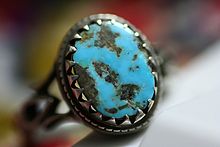
Mashhad is Iran's second largest
According to the writings and documents, the oldest existing carpet attributed to the city belongs to the reign of Shah Abbas (
With more than 55% of all the
Unemployment, poverty, drug addiction, theft, and sexual exploitation are the most important social problems of the city.[71]
The divorce rate in Mashhad had increased by 35 percent by 2014.[72][73] Khorasan and Mashhad ranked the second in violence across the country in 2013.[74]
Astan Quds Razavi
At the same time, the city has kept its character as a goal of pilgrimage, dominated by the strength of the economic and political authority of the Astan Quds Razavi, the administration of the Shrine waqf, probably the most important in the Muslim world[citation needed] and the largest active bonyad in Iran.[75] The Astan Quds Razavi is a major player in the economy of the city of Mashhad.[76] The land occupied by the shrine has grown fourfold since 1979 according to the head of the foundation's international relations department. The Shrine of Imam Reza is vaster than Vatican City.[75] The foundation owns most of the real estate in Mashhad and rents out shop space to bazaaris and hoteliers.[76] The main resource of the institution is endowments, estimated to have annual revenue of $210 billion.[77] Ahmad Marvi is the current Custodian of Astan Quds Razavi.
Padideh Shandiz

Credit institutions
Several credit institutions have been established in Mashhad, including Samenolhojaj (مؤسسه مالی و اعتباری ثامن الحجج), Samenola'emmeh (مؤسسه اعتباری ثامن) and Melal (formerly Askariye, مؤسسه اعتباری عسکریه). The depositors of the first institution have faced problem in receiving cash from the institution.[79][80][81]
Others
The city's International Exhibition Center is the second most active exhibition center after Tehran, which due to proximity to Central Asian countries hosts dozens of international exhibitions each year.[citation needed] Companies such as Smart-innovators in Mashhad are pioneers in electrical and computer technology.[citation needed]
Language
The language mainly spoken in Mashhad is Persian with a variating Mashhadi accent, which can at times, prove itself as a sort of dialect.[82] The Mashhadi Persian dialect is somewhat different from the standard Persian dialect in some of its tones and stresses.[83][84] Today, the Mashhadi dialect is rarely spoken by young people of Mashhad; most of them perceive it as a humiliation. This is thought to be related to the non-positive performance of the Islamic Republic of Iran Broadcasting (IRIB).[85]
Culture
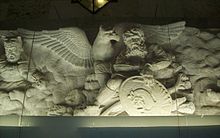
Religious seminaries
Long a center of secular and religious learning, Mashhad has been a center for the
The

Mashhad is also home to one of the oldest libraries of the Middle-East called the Central Library of Astan Quds Razavi with a history of over six centuries. There are some six million historical documents in the foundation's central library. A museum is also home to over 70,000 rare manuscripts from various historical eras.

The Astan Quds Razavi Central Museum, which is part of the Astan-e Quds Razavi Complex, contains Islamic art and historical artifacts. In 1976, a new edifice was designed and constructed by the well-known Iranian architect Dariush Borbor to house the museum and the ancient manuscripts.
In 1569 (977 H), 'Imad al-Din Mas'ud Shirazi, a physician at the Mashhad hospital, wrote the earliest Islamic treatise on syphilis, one influenced by European medical thought. Kashmar rug is a type of
Mashhad active galleries include: Mirak Gallery, Parse Gallery, Rezvan Gallery, Soroush Gallery, and the Narvan Gallery.
During the recent years, Mashhad has been a clerical base to monitor the affairs and decisions of state. In 2015, Mashhad's clerics publicly criticized the performance of concert in Mashhad, which led to the order of cancellation of concerts in the city by
Newspapers
There are two influential newspapers in Mashhad, Khorasan (خراسان) and Qods (قدس), which have been considered "conservative newspapers". They are two Mashhad-based daily published by and representing the views of their current and old owners: Foundation of Martyrs and Veterans Affairs and Astan Quds Razavi, respectively.[87]
Capital of Islamic culture
The
Social harm
Mashhad is one of the most populous cities in Iran. The city of Mashhad, despite the many job capacities it has created for different groups of people, is also suffering from various social harms. Among the most important social challenges of this city, we can mention the increase in unemployment, traffic, poverty and prostitution.
Main sites


Apart from Imam Reza shrine, there are a number of large parks, the tombs of historical celebrities in nearby Tus and Nishapur, the tomb of Nader Shah and Koohsangi park. The Koohestan Park-e-Shadi Complex includes a zoo, where many wild animals are kept and which attracts many visitors to Mashhad. It is also home to the Mashhad Airbase (formerly Imam Reza airbase), jointly a military installation housing Mirage aircraft, and a civilian international airport. Khurshid castle, Vakil Abad Park, Miniature Park, Professor Bazima Science Park, Astan Quds Razavi Museum, Keshti Dome, Harunieh Dome, Bird Garden, Anthropology Museum or Mehdi Qolibek Bath, Mellat Park, Naderi Museum and Bread Museum They are among other sightseeing centers of Mashhad.

Some points of interest lie outside the city: the tomb of Khajeh Morad, along the road to Tehran; the tomb of Khajeh Rabi' located 6 kilometres (3.7 miles) north of the city where there are some inscriptions by the renowned Safavid calligrapher Reza Abbasi; and the tomb of Khajeh Abasalt, a distance of 20 kilometres (12 miles) from Mashhad along the road to Neishabur (the three were all disciples of Imam Reza).
Among the other sights are the tomb of the poet Ferdowsi in Tus, 24 kilometres (15 miles) distance, and the summer resorts at Torghabeh, Torogh, Akhlamad, Zoshk, and Shandiz.
The Shah Public Bath, built during the Safavid era in 1648, is an outstanding example of the architecture of that period. It was recently restored, and is to be turned into a museum.
Transportation
Airport

Mashhad is served by the
It is connected to 57 destinations and has frequent flights to 30 cities within Iran and 27 destinations in the Central Asia, the Middle East, East Asia and Europe.[90]
The airport has been under a US$45.7 ml vast expansion project which has been finished by opening a new Haj Terminal with 10,000 m area on 24 May 2010 and followed by opening a new international terminal with 30000 m2 area with a new parking building, a new custom storage and cargo terminal, new safety and fire fighting buildings and upgrades to taxiways and equipment. Another USD26.5 ml development project for construction of new hangar for aircraft repair facilities and expansion of the west side of the domestic terminal is underway using a BOT contract with the private sector.[citation needed]
Rail
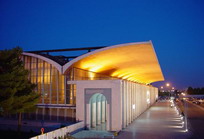

A new service from Nakhchivan, Azerbaijan, to Mashhad, Iran, was launched in December 2016.[95]
Railway & Subway
Mashhad Urban Railway Corporation (MURCO) is constructing

The second line which is a metro line with 14.5 km length and 13 stations. line 2 construction is going to finish in early 2020. The first phase of line 2 with 8 kilometers and 7 stations is started on 21 February 2017. On 20 March two stations were added to the network in test operational mode and the first interchange station was added to the network. On 7 May 2018, Iranian President Hassan Rouhani took part in the inauguration ceremony of the first Mashhad Urban Railway interchange station, "Shariati", which connects line 1 and 2.[98] in 27 July shahid Kaveh station operation began and the length of the operational part of line 2 reached to 13.5 kilometers. On 18 November 2019 Alandasht station Began operative. Currently, line 2 operates every day with 13.5 km and 11 stations from 6 am to 10 pm, and the current headway is 10 minutes.[99] Currently Mashhad Urban Railway Operation Company (MUROC)[96] operates 2 lines with 37.5 kilometers length and 35 stations. Tunnel excavation of line 3 has begun and more than 14 kilometers of tunnel excavation is done using two Tunnel Boring Machines[100] and operation of the first phase of line 3 is expected to start in 2021. Tunnel Excavation of line 4 is going to start in summer 2019.[101]
Road
).
Bus

Government and politics
Astan Quds
Astan Quds which controls the shrine- the tourism driver- is a wealthy tax exempt religious/political organization. It is recommended to reduce poverty in city a Bazaar be opened by poor people in a courtyard.[102]
Members of Parliament
Mashhad's current members of parliament are described as politicians with fundamentalist conservative tendencies, who are mostly the members of Front of Islamic Revolution Stability, an Iranian principlist political group. They were elected to the Parliament on 26 February 2016.
Members of Assembly of Experts
City Council and mayor
In 2013, an Iranian principlist political group,
Universities and colleges
Universities
- Ferdowsi University of Mashhad
- Ferdowsi University of Mashhad – International Campus
- Golbahar University of Science and New Technology
- Imam Reza International University Archived 5 March 2018 at the Wayback Machine
- Islamic Azad University of Khorasan – Golbahar International Campus
- Islamic Azad University of Mashhad
- Khayyam University
- Mashhad University of Medical Sciences at the Wayback Machine (archived 24 March 2017)
- Payame Noor University of Mashhad
- Razavi University of Islamic Sciences
- Sadjad University of Technology at the Wayback Machine (archived 7 May 2010)
- Sama Technical and Vocational Training Center (Islamic Azad University of Mashhad)
- Sport Sciences Research Institute of Iran
Colleges
- Al Mustafa International University
- Alzahra Girls Technical and Vocational College of Mashhad (Technical and Vocational University) at the Wayback Machine (archived 7 June 2013)
- Arman Razavi Girls Institute of Higher Education
- Asrar Institute of Higher Education
- Attar Institute of Higher Education
- Bahar Institute of Higher Education Archived 11 October 2017 at the Wayback Machine
- Binalood Institute of Higher Education
- Cultural Heritage, Hand Crafts, and Tourism Higher Education Center (University of Science and Technology)
- Eqbal Lahoori Institute of Higher Education
- Ferdows Institute of Higher Education at the Wayback Machine (archived 6 May 2015)
- Hakim Toos Institute of Higher Education
- Hekmat Razavi Institute of Higher Education
- Iranian Academic Center for Education, Culture and Research, Mashhad Branch (Jahad Daneshgahi of Mashhad)
- Jahad Keshavarzi Higher Education Center of Khorasan Razavi (Shahid Hashemi Nejad)
- Kavian Institute of Higher Education
- Kharazmi Azad Institute of Higher Education of Khorasan
- Khavaran Institute of Higher Education
- Kheradgarayan Motahar Institute of higher education
- Khorasan Institute of Higher Education
- Khorasan Razavi Judiciary Center (University of Science and Technology)
- Khorasan Razavi Municipalities' Institute of Research, Education, and Consultation of (University of Science and Technology)
- Mashhad Aviation Industry Center (University of Science and Technology)
- Mashhad Aviation Training Center (University of Science and Technology)
- Mashhad Culture and Art Center 1 (University of Science and Technology)
- Mashhad Koran Reciters Society
- Mashhad Prisons Organization Center (University of Science and Technology)
- Mashhad Tax center (University of Science and Technology)
- Navvab Higher Clerical School
- Part Tyre Center (University of Science and Technology)
- Red Crescent Society of Khorasan Razavi (University of Science and Technology)
- Salman Institute of Higher Education
- Samen Teacher Training Center of Mashhad (Farhangian University)
- Samen Training Center of Mashhad (Technical and Vocational University)
- Sanabad Golbahar Institute of Higher Education
- Shahid Beheshti Teacher Training College (Farhangian University) Archived 26 April 2017 at the Wayback Machine
- Shahid Hashemi Nejad Teacher Training College (Farhangian University) Archived 26 February 2016 at the Wayback Machine
- Shahid Kamyab Teacher Training Center at the Wayback Machine (archived 15 August 2012)
- Shahid Montazari Technical Faculty (Technical and Vocational University) at the Library of Congress Web Archives (archived 17 October 2015)
- Shandiz Institute of Higher Education
- Khorasan Razavi Taavon Center (University of Science and Technology) Archived 23 March 2017 at the Wayback Machine
- Tabaran Institute of Higher Education
- Toos Institute of Higher Education
- Toos Porcelain Center (University of Science and Technology)
- Varastegan Medical Sciences Institute of Higher Education at the Wayback Machine (archived 23 March 2017)
- Khorasan Water and Electricity Industry Center (University of Science and Technology)
- Workers' House; Mashhad Branch (University of Science and Technology)
Sports



Major sport teams
| Club | League | Sport | Venue | Established |
|---|---|---|---|---|
| Abumoslem F.C. | Iran Pro League |
Football | Takhti Stadium | 1907
|
| Shahr Khodro F.C. | Iran Pro League |
Football | Imam Reza Stadium | 2007
|
| Siah Jamegan F.C. | Iran Pro League |
Football | Takhti Stadium | 1970
|
| Samen Mashhad BC | Basketball | Shahid Beheshti Sport Complex | 2011
| |
| Mizan Khorasan VC | Volleyball | Shahid Beheshti Sport Complex | 2010
| |
| Farsh Ara Mashhad FSC | Futsal | Shahid Beheshti Sport Complex | 1994
| |
| Ferdosi Mashhad FSC | Futsal | Shahid Beheshti Sport Complex | 2011
| |
| Rahahan Khorasan W.C. | Freestyle wrestling | Mohammad Ali Sahraei Hall[109] | 1995
|
Other sports

City was host to 2009 Junior World Championships in sitting volleyball where Iran's junior team won Gold.
Wrestling is one of the most popular sports in this city. Pahlevani and zoorkhaneh rituals have a special place in Mashhad and is one of the most important zoorkhaneh in Iran in Mashhad.[110]
Mashhad cycling track was introduced in 2011 as the most equipped cycling track in Iran; Car racing track, motorcycle track and motocross track, three skating rinks, ski track and equestrian track in Mashhad are other sports tracks in Mashhad. The first golf course in Iran is located in the Samen complex of Mashhad.[111][112]
Gallery
- Some photos of Mashhad (The City of Paradise)
-
Mashhad at night
-
Ferdowsi Tomb
-
Tomb of Nader Shah Afshar
-
Faculty of Science, Ferdowsi University of Mashhad
-
Hotel Homa
-
Mashhad Railway Station
-
Ferdowsi Museum
-
Almas Shargh (East Diamond) Shopping Center
-
Ferdowsi's self-narration at the end of his life
-
Homa Watch
-
Former Statue Sq. element
-
International 5 stars hotels
-
Mashhad Arman Mall
-
Padideh Shandiz Tourism Center
-
Toos Restaurant
-
Mashhad Arman Mall
-
The replica of Radkan calendar structure
-
Shandiz Restaurant, serving traditional Iranian cuisine
-
Tombstone of Nader and Ferdowsi
-
Mellat Park
-
Kang countryside
-
Koohestan Park
-
Sheshlik, one of the Iranian tasty foods in Mashhad
-
Mashhad is the major trade center of saffron in Iran.
-
Sheepskin (Poostin) industry of Mashhad and Shandezh
-
Stone carving art
-
Stone and gem (Sang & GoharSang) industry
-
A Masterpiece in Mashhad metro station
-
Fereydoon Seddiqi's prominent stone motifs
-
Zaal & Simorgh Story
-
Emam Reza Historic Hospital
-
St. MesropArmenian church in Mashhad
-
Tous
-
Arg Structure
-
Malek's House in Mashhad
-
Daroogheh Historical House
-
Mashhad Firefighter's Parade
-
Mashhad Firefighter's Parade
-
Bike lane of Mashhad
-
Mashhad Airport Terminal
-
Mashhad Intl. Airport
-
Old picture of Mashhad Intl. Airport
-
Old picture of Mashhad Railway Station
-
TV Square
-
Imam Hossein Square and Kalaat Road
-
Mashhad Metro
-
Ferdowsi Sq.
-
Homa Hotel, Branch of Homa Hotel Group
-
Alton Tower
-
Tous Museum near Mashhad
-
Shandiz, a tourist town near Mashhad
-
Some Iranian Handicrafts (metalwork) in Torghabeh
-
Mashhad's countryside
-
Afsharid Empire era at NaderiMuseum
-
Mashhad Metro (LRT) Station
-
Mashhad Metro entrance and urban design
-
Al-Rabi ibn Khuthaym (Khajeh Rabie Tomb)
-
A mosque in Mashhad
-
Goharshad Mosque, Abbasid Ivan in Atiq yard
-
Kang countryside
-
Oven of Rastgar Moqaddam
-
Mashhad Solar Power Plant
-
Mashhad Farabi Hospital
-
Tulips in Mellat Park
-
Mellat Park
-
Night shot of Mellat Park
-
Metro boarding card charging area
-
Mashhad Botanic Garden
-
Almas Shargh Shopping Center
-
Mashhad Electric bus named Shetab
-
Traffic playground to learn kids traffic rules
-
Snow in Mashhad, December 2012
Mashhad as capital of Persia and independent Khorasan
The following
- Kianid Dynasty
- Malek Mahmoud Sistani 1722–1726
- Afsharid dynasty
- Nader Shah
- Adil Shah
- Ebrahim Afshar
- Shahrukh Afshar
- Nadir Mirza of Khorasan
- Safavid dynasty
- Soleyman II
- Autonomous Government of Khorasan
- Colonel Mohammad Taghi Khan Pessyan
Notable people from Mashhad and Toos
Artists
-
Abolghasem Ferdowsi Pazh, one of the world's longest epic poems created by a single poet, and the greatest epic of Persian speaking countries
Music
-
National Order of Merit (France).
-
Darya Dadvar, soprano soloist and composer
-
Tamin and A-del in 25 (Toos) band
Cinema
-
Ovanes Ohanian, Director
-
Amir Ghavidel, Art Director
-
Mehdi Sabbagh zade, Director, screenwriter and producer
-
Kourosh Ahari, Director, screenwriter and producer
-
Mohammad Moti', actor
-
Reza Kianian, actor
-
Anoushirvan Arjmand, actor
-
Reza Attaran, actor
-
Borzoo Arjmand, actor
-
Mitra Hajjar, actress
-
Sare Bayaat, actress
-
Hamed Behdad, actor
-
Hamid Reza Sadr, film and football critic and journalist
-
Homayun, actor
-
Mohammad Shiri, actor
-
Dariyush Arjmand, actor
-
Hassan Raziani, actor
-
Iran Darroodi, Surreal painter
-
Reza Rafi', poet
- 25band, both singers born in Mashhad; Pop Group formed in 2010
- Abdi Behravanfar, born June 1975 in Mashhad; an Iranian singer, guitar player and singer-songwriter
- Ali "Dubfire" Shirazinia, born 19 April 1971; musician/dj (co-founder of Deep Dish)
- Amir Ghavidel, March 1947 – November 2009; an Iranian director and script writer
- Anoushirvan Arjmand, Iranian actor
- Borzoo Arjmand, born 1975 in Mashhad; Iranian cinema, theatre and television actor
- Dariush Arjmand, Iranian actor
- Darya Dadvar, born 1971 in Mashhad; an accomplished Iranian soprano soloist and composer
- Hamed Behdad, born 17 November 1973 in Mashhad; Iranian actor
- Hamid Motebassem, born 1958 in Mashhad; Iranian musician and tar and setar player
- Hosein Eblis is considered one of pioneers of "Persian Rap" along with Hichkas and Reza Pishro.
- Homayoun Shajarian, Mohammad-Reza Shajarian's son, born 21 May 1975; renowned Persian classical music vocalist, as well as a Tombak and Kamancheh player
- Iran Darroudi, born 2 September 1936 in Mashhad; Iranian artist
- Javad Jalali, born 30 May 1977 in Mashhad; Iranian photographer and cinematographer
- Mahdi Bemani Naeini, born 3 November 1968; Iranian film director, cinematographer, TV cameraman and photographer
- Marshall Manesh, born 16 August 1950 in Mashhad; Iranian-American actor
- Mitra Hajjar, born 4 February 1977; Iranian actress
- Mohammad-Reza Shajarian, born 23 September 1940 in Mashhad; internationally and critically acclaimed Persian traditional singer, composer and Master (Ostad) of Persian music
- Mohsen Namjoo, born 1976 in Torbat-e-Jaam; Iranian singer-songwriter, author, musician and setar player
- Navid Negahban, born 2 June 1968 in Mashhad; Iranian-American actor
- Noureddin Zarrinkelk, born 1937 in Mashhad; renowned Iranian animator, concept artist, editor, graphic designer, illustrator, layout artist, photographer, script writer and sculptor
- Ovanes Ohanian, ?–1961 Tehran; Armenian-Iranian filmmaker who established the first film school in Iran
- Pouran Jinchi, born 1959 in Mashhad; Iranian-American artist
- Rafi Pitts, born 1967 in Mashhad; internationally acclaimed Iranian film director
- Reza Attaran, born 31 March 1968 in Mashhad; Iranian actor and director
- Reza Kianian, born 17 July 1951 in Mashhad; Iranian actor
- Shahin Ebrahimzadeh-Pezeshki, born 1958 in Mashhad; Persian textile and costume art historian, historian of tribal costumes, textile artist, author, researcher and curator
Entrepreneurs
-
Hoseyn Sabet, businessman and Achaemenid art lover
-
co-founder and chairman of Prodea Systems, co-founder and CEO of Telecom Technologies, Inc. (TTI), sponsor of the Ansari X Prize
- Anousheh Ansari, born 12 September 1966; the Iranian-American co-founder and chairman of Prodea Systems, Inc., and a spaceflight participant with the Russian space program
- Hossein Sabet, Iranian businessman and Persian carpet dealer who owns Sabet International Trading Co.
- Mahmoud Khayami, born 1930 in Mashhad, Iran; Iranian born industrialist and philanthropist, of French nationality
Sports
-
Heshmat Mohajerani, footballer and former football manager
-
Maryam Sedaarati, athlete
-
Rasoul Khadem, wrestling coach
-
Farhad Zarif, volleyball player
- Abbas Chamanyan, Iranian football coach, manager and former player
- Abbas Golmakani, World's wrestling champion during the 1950s
- Abolfazl Safavi, Iran professional football player for Aboumoslem team in Takhte Jamshid League. He was later executed in prison by the Iranian regime in 1982 for his affiliation with Iranian opposition, the MEK.
- Ali Baghbanbashi, athlete
- Alireza Vahedi Nikbakht, born 30 June 1980 in Mashhad; Iranian professional football player
- Amir Ghaseminejad, judoka
- Amir Reza Khadem, born 10 February 1970 in Mashhad, wrestler
- Amir Tavakkolian, wrestler
- Farbod Farman, basketballer
- Farhad Zarif, born 3 March 1983, volleyballer
- Ghodrat Bahadori, Iranian futsaler/indoor soccer player
- Hamed Afagh, basketballer
- Hamid Reza Mobarez, swimmer
- Hasan Kamranifar, Iranian football referee
- Heshmat Mohajerani, born January 1936 in Mashhad, Iran; Iranian football coach, manager and former player
- Hossein Badamaki, Iranian professional football player
- Hossein Ghadam, Iran professional football player for Aboumoslem team
- Hossein Sokhandan, Iranian football referee
- Hossein Tayyebi, Iranian futsaler/indoor soccer player
- Javad Mahjoub, judoka
- Khodadad Azizi, born 22 June 1971 in Mashhad, Iran; retired professional football striker
- Kia Zolgharnain, Iranian-American former futsaler/indoor soccer player Kourosh Khani, racing driver
- Mahdi Javid, Iranian futsaler/indoor soccer player
- Majid Khodaei, wrestler
- Maryam Sedarati, athlete. Iran record holder in women high jump for three decades.
- Masoud Haji Akhondzadeh, judoka
- Mohammad Khadem, wrestler
- Mohammad Mansouri, Iranian professional football player
- Mohsen Ghahramani, Iranian football referee
- Mohsen Torki, Iranian football referee
- Rasoul Khadem, born 17 February 1972 in Mashhad; wrestler
- Reza Enayati, Iranian professional football player
- Reza Ghoochannejhad, Iranian-Dutch professional football player
- Rouzbeh Arghavan, basketballer
Religious and political figures
- Abbas Vaez-Tabasi, 25 June 1935 – 4 March 2016; Grand Imam and Chairman of the Astan Quds Razavi board
- Abdolreza Rahmani Fazli, born 1959 in Shirvan; Interior Minister of President Hassan Rouhani
- Abu Muslim Khorasani, c. 700–755; Abu Muslim Abd al-Rahman ibn Muslim al-Khorasani, Abbasid general of Persian origin
- Al-Ghazali, 1058–1111; Islamic theologian, jurist, philosopher, cosmologist, psychologist and mystic of Persian origin
- Al-Hurr al-Aamili, Shia scholar and muhaddith
- Ali al-Sistani, born approximately August 4, 1930; Twelver Shi'a marja residing in Iraq since 1951
- Ebrahim Raisi, b. 1960; scholar and President-elect of Iran
- Goharshad Begum, Persian noble and wife of Shāh Rukh, the emperor of the Timurid dynasty of Herāt
- Hadi Khamenei, b. 1947; mid-ranking cleric who is a member of the reformist Association of Combatant Clerics
- Hassan Ghazizadeh Hashemi, born 21 March 1959 in Fariman; Minister of Health and Medical Education of President Hassan Rouhani
- Hassan Rahimpour Azghadi, Conservative political strategist and television personality in the Islamic Republic of Iran
- Hossein Vahid Khorasani, born in 1924; Iranian Twelver Shi'a Marja
- Mohammad-Ali Abtahi, born January 27, 1958; former Vice President of Iran and a close associate of former reformist President Khatami
- Mohammad Bagher Ghalibaf, born 23 August 1961 in Torghabeh, near Mashhad; the former Mayor of Tehran and current Speaker of Parliament
- Mohammad-Kazem Khorasani, 1839–1911; Twelver Shi'a Marja, Persian (Iranian) politician, philosopher and reformer
- Morteza Motahhari, 31 January 1919 in Fariman – 1 May 1979; an Iranian cleric, philosopher, lecturer and politician
- Nasir al-Din al-Tusi, born February 1201 in Tūs, Khorasan – 26 June 1274 in al-Kāżimiyyah, near Baghdad; Persian of the Ismaili and subsequently Twelver Shī'ah Islamic belief
- Nizam al-Mulk, 1018 – 14 October 1092; celebrated Persian scholar and vizier of the Seljuq Empire
- Saeed Jalili, born 1965 in Mashhad; Iranian politician and the former present secretary of Iran's Supreme National Security Council
- Seyed Hassan Firuzabadi, current major general, Islamic Republic of Iran
- Seyyed Ali Khamenei, born 17 July 1939; former president and current supreme leader of Iran
- Shahrukh (Timurid dynasty), August 20, 1377 – March 12, 1447; ruler of the eastern portion of the empire established by the Central Asian warlord Timur (Tamerlane)
- Shaykh Tusi, 385–460 A.H.; prominent Persian scholar of the Shi'a Twelver Islamic belief
- Sheikh Ali Tehrani, brother-in-law of Seyyed Ali Khamenei, currently living in Iran. He is one of the oppositions of current Iranian government.
Pahlavic politicians
-
Abdol-Hoseyn Teymoortash, influential Iranian statesman who served as the first minister of court of the Pahlavi dynasty
-
Sadrolmolook Bozorgnia, Representative of the National Assembly
-
Ali Bozorgnia
-
Amirteymour Kalali, prominent statesman
- Abdolhossein Teymourtash, prominent Iraninan statesman and first minister of justice under the Pahlavis
- Amirteymour Kalali, prominent Iraninan statesman
- Manouchehr Eghbal, 14 October 1909 – 25 November 1977; a Prime Minister of Iran
Science & scientists
- Abū al-Wafā' Būzjānī, 10 June 940 – 1 July 998; Persian mathematician and astronomer
- Abū Ja'far al-Khāzin, 900–971; Persian astronomer and mathematician from Khorasan
- physicist and pharmacist and physician
- Nasir al-Din al-Tusi, born February 1201 in Tūs, Khorasan – 26 June 1274 in al-Kāżimiyyah near Baghdad; Persian of the Ismaili and subsequently Twelver Shī'ah Islamic belief
- Sharaf al-Dīn al-Ṭūsī, 1135–1213; Persian mathematician and astronomer of the Islamic Golden Age (during the Middle Ages)
- Mohsen Baqerzada, publisher and manager of Toos publication
Writers and literatures
- Abolfazl Beyhaqi, 995–1077; a Persian historian and author
- Ali Akbar Fayyaz, a renowned historian of early Islam and literary critic, founder of the School of Letters and Humanities at the Ferdowsi University of Mashhad
- Abu-Mansur Daqiqi, 935/942–976/980
- Abusa'id Abolkhayr, 7 December 967 – 12 January 1049 / Muharram ul Haram 1, 357 – Sha'aban 4, 440 AH; a Persian Sufi who contributed extensively to the evolution of Sufi tradition
- Anvari, 1126–1189; one of the greatest Persian poets
- Asadi Tusi, born in Tus, Iranian province of Khorasan, died in 1072 in Tabriz, Iran; Persian poet of Iranian national epics
- Ferdowsi, 935–1020 in Tus; a Persian poet
- Mehdi Akhavan-Sales, 1928, Mashhad, Iran – 1990, Tehran, Iran; a Persian poet
- Chain Murders of Iran
- Mohammad-Taghi Bahar, 6 November 1884, Mashhad, Iran – 22 April 1951, Tehran, Iran
-
Asghar Imanian, fighter pilot
-
Pari Mohammadzade Omid, Heavy vehicle driver
Twin towns – sister cities
 Karachi, Pakistan
Karachi, Pakistan Karbala, Iraq
Karbala, Iraq Kuala Lumpur, Malaysia
Kuala Lumpur, Malaysia Lahore, Pakistan
Lahore, Pakistan Mazar-i-Sharif, Afghanistan
Mazar-i-Sharif, Afghanistan Najaf, Iraq
Najaf, Iraq Ürümqi, China
Ürümqi, China
Consulates
Active
 Kyrgyzstan (1996–)
Kyrgyzstan (1996–) Pakistan (1975–)[114][115][116][117]
Pakistan (1975–)[114][115][116][117] Turkey (1919–?,1930–?, 2014–)[118][119]
Turkey (1919–?,1930–?, 2014–)[118][119] Turkmenistan (1995–)
Turkmenistan (1995–)
Former
 United Kingdom (1889–1975)[120]
United Kingdom (1889–1975)[120] Russia (1889–1917)
Russia (1889–1917) Soviet Union (1917–1937, 1941–1979)
Soviet Union (1917–1937, 1941–1979) China (1941–?)[121]
China (1941–?)[121] United States (1949–1979)[122]
United States (1949–1979)[122] Poland[123]
Poland[123] India
India Japan
Japan Jordan
Jordan Lebanon
Lebanon West Germany (c. 1984)
West Germany (c. 1984) Kazakhstan (1995–2009)[124]
Kazakhstan (1995–2009)[124] Saudi Arabia (2004–2016)[125]
Saudi Arabia (2004–2016)[125]
See also
- The National Library of Astan Quds Razavi
- Mashadi Jewish Community
- Sport Sciences Research Institute of Iran
Notes
References
- ^ OpenStreetMap contributors (4 May 2023). "Mashhad, Mashhad County" (Map). OpenStreetMap. OpenStreetMap. Retrieved 4 May 2023.[self-published source]
- ^ https://www.metropolis.org/member/mashhad
- ^ "Local Government Profile". United Nations Office for Disaster Risk Reduction. Archived from the original on 22 February 2014. Retrieved 4 February 2014.
- ^ "Major Agglomerations of the World – Population Statistics and Maps". citypopulation.de. 13 September 2018. Archived from the original on 13 September 2018.
- ^ "Statistical Center of Iran > Home".
- ^ a b c d "Sacred Sites: Mashhad, Iran". sacredsites.com. Archived from the original on 27 November 2010. Retrieved 13 March 2006.
- ^ "Mashhad". Encyclopædia Britannica. Retrieved 6 January 2018.
- ^ Sharafedin, Bozorgmehr (29 December 2017). "Hundreds protest against high prices in Iran". Reuters. Retrieved 7 January 2018.
- ^ Dockery, Wesley (3 January 2018). "Iran protests: Arab states between trepidation and glee". DW. Deutsche Welle. Retrieved 7 January 2018.
- ^ The Cosmopolitan. Vol. 6. 1889. p. 378.
- ^ a b Simigh, Agnes (29 August 2022). "THE BEST PLACES TO VISIT IN MASHHAD, THE HOLIEST CITY IN IRAN". Voice of Guides. Retrieved 6 October 2022.
- ^ "Kuwait to evacuate 700 citizens from Iran's Mashhad amid coronavirus fears". Al Arabiya English. 22 February 2020. Retrieved 6 October 2022.
- ^ Habibi, Hassan (21 June 1369). "Approval of the organization and chain of citizenship of the elements and units of the divisions of Khorasan province, centered in Mashhad". Islamic Parliament Research Center (in Persian). Ministry of Interior, Defense Political Commission of the Government Board. Archived from the original on 17 November 2015. Retrieved 6 January 2024.
- ^ "Razavi Khorasan (Iran): Counties & Cities – Population Statistics in Maps and Charts". citypopulation.de.
- ^ مشهد، پایتخت معنوی ایران اعلام شد [Mashhad, Iran's spiritual capital] (in Persian). Khorasan newspaper. Archived from the original on 7 July 2015.
- ^ نامگذاري مشهد به عنوان پايتخت معنوي "Nombramiento de Mashhad como capital espiritual de Irán" (in Persian). Shahr.ir. 1 November 2009. Archived from the original on 26 October 2013. Retrieved 26 October 2013.
- ^ Diodorus (17.77.5)
- ^ Curtius (6.6.4-5)
- ^ Justin (12.3.8 )
- ^ Arrian (4.9.9)
- ^ Tabvla Pevtingeriana, Segmentvm XII - M. Weber
- ^ Pliny, Nat. 6.29
- ^ muhammad-bagher al-majlisi, bahaar-ol-anvaar
- ^ feiz al-kashaani, al-vaafi
- ^ al-kaafi
- ^ al-ghoybah
- ^ jaami-ol-akhbaar
- ^ al-vaafi
- ^ E.J. Brill's First Encyclopaedia of Islam 1913–1936 p. 127
- ^ The Shias: A Short History, Heinz Halm, p. 26
- ^ "Iran travel Information". persiatours.com.
- ^ "Hystaspes (2) – Livius". livius.org. Retrieved 7 January 2018.
- ^ Zabeth (1999) pp. 12–13.
- ^ Zabeth (1999) pp. 13–16.
- ^ موسوي 1370, p. 40
- ^ a b Zabeth (1999) pp. 14–15.
- ^ "Traditional foods of Mashhad City". Archived from the original on 11 May 2017. Retrieved 22 December 2016.
- ^ "زبان و ادبیات ترکان خراسان – غذاهای سنتی گریوان". salariyan.blogfa.com.
- ^ نوایی، عبدالحسین. کریم خان زند
- ISBN 978-1-86064-629-4. Retrieved 4 November 2012.
- ISBN 978-0-85772-173-0.
- ^ a b تاریخجه شهر مشهد, "Historia de la ciudad de Mashhad". Portal de la Universidad de Ciencias Médicas de Mashhad (in Persian). Archived from the original on 29 October 2013. Retrieved 27 October 2013.
- ^ Ervand, History of Modern Iran, (2008), p.94
- ^ Bakhash, Shaul, Reign of the Ayatollahs: Iran and the Islamic Revolution by Shaul, Bakhash, Basic Books, 1984, p. 22.
- ^ "Iran / Mashhad Bombing #154427". Vanderbilt Television News Archive. 20 June 1994. Retrieved 19 June 2009.
- ^ "Explosive circles: Iran. (Mashhad bombing)". The Economist. 25 June 1994. Archived from the original on 16 October 2012. Retrieved 19 June 2009 – via HighBeam Research.
- ^ "Context of 'Mid-1994: Ramzi Yousef Works Closely with Al-Qaeda Leaders". History Commons. Archived from the original on 20 July 2014. Retrieved 25 March 2010.
- ^ "Archived copy" (PDF). Archived from the original (PDF) on 3 July 2014. Retrieved 27 February 2008.
{{cite web}}: CS1 maint: archived copy as title (link) - ^ NOAA. p. 5. Retrieved 18 February 2024.
Parameter Code: 47 Number of Days with Snowfall
- )
- ^ a b *"Highest record temperature in Mashhad by Month 1951–2010". Iran Meteorological Organization. Archived from the original on 4 February 2019. Retrieved 8 April 2015.
- "Lowest record temperature in Mashhad by Month 1951–2010". Iran Meteorological Organization. Archived from the original on 4 February 2019. Retrieved 8 April 2015.
- ^ *"Average Maximum temperature in Mashhad by Month 1951–2010". Iran Meteorological Organization. Archived from the original on 8 March 2016. Retrieved 8 April 2015.
- "Average Mean Daily temperature in Mashhad by Month 1951–2010". Iran Meteorological Organization. Archived from the original on 18 October 2018. Retrieved 8 April 2015.
- "Average Minimum temperature in Mashhad by Month 1951–2010". Iran Meteorological Organization. Archived from the original on 8 March 2016. Retrieved 8 April 2015.
- ^ "Monthly Total Precipitation in Mashhad by Month 1951–2010". Iran Meteorological Organization. Archived from the original on 15 September 2018. Retrieved 8 April 2015.
- ^ "Average relative humidity in Mashhad by Month 1951–2010". Iran Meteorological Organization. Archived from the original on 8 March 2016. Retrieved 8 April 2015.
- ^ "No. Of days with precipitation equal to or greater than 1 mm in Mashhad by Month 1951–2010". Iran Meteorological Organization. Archived from the original on 8 March 2016. Retrieved 8 April 2015.
- ^ "No. Of days with snow in Mashhad by Month 1951–2010". Iran Meteorological Organization. Archived from the original on 8 March 2016. Retrieved 8 April 2015.
- ^ "Monthly total sunshine hours in Mashhad by Month 1951–2010". Iran Meteorological Organization. Archived from the original on 8 March 2016. Retrieved 8 April 2015.
- ^ Iran: Provinces and Cities population statistics
- ^ "Census of the Islamic Republic of Iran, 1385 (2006)". AMAR (in Persian). The Statistical Center of Iran. p. 09. Archived from the original (Excel) on 20 September 2011. Retrieved 25 September 2022.
- ^ "Census of the Islamic Republic of Iran, 1390 (2011)". Syracuse University (in Persian). The Statistical Center of Iran. p. 09. Archived from the original (Excel) on 20 January 2023. Retrieved 19 December 2022.
- ^ "Census of the Islamic Republic of Iran, 1395 (2016)". AMAR (in Persian). The Statistical Center of Iran. p. 09. Archived from the original (Excel) on 2 April 2022. Retrieved 19 December 2022.
- ^ "-نصف-اقامت-مسافران-یزد-کاشان-کاهش-یافت". Masshad News (in Persian). Archived from the original on 4 February 2019. Retrieved 22 December 2016.
- ^ Unallowable places farsnews.ir
- ^ The double lives of Mashhadi Jews, The Jerusalem Post, 12 August 2007.
- ^ Iran Foreign Policy & Government Guide (World Business Law Handbook Library), Usa Ibp, Intl Business Pubn., 2006, p. 149
- ^ Glazebrook & Abbasi-Shavazi 2007, p. 189
- ^ Abbas Hajimohammadi and Shaminder Dulai, eds. (6 November 2014). "Photos: The Life of Afghan Refugees in Tehran". Newsweek. Retrieved 7 November 2014.
- ^ Koepke, Bruce (4 February 2011), "The Situation of Afghans in the Islamic Republic of Iran Nine Years After the Overthrow of the Taliban Regime in Afghanistan", Middle East Institute. Retrieved 7 November 2014
- ^ "مهاجرت افغانها برای همسایه دردسرساز شد/ سرنوشت خاکستری اتباع خارجی در مشهد". خبرگزاری مهر – اخبار ایران و جهان – Mehr News Agency. 1 January 2017. Retrieved 31 December 2016.
- ^ correspondent, Tehran Bureau (7 May 2015). "Prayer, food, sex and water parks in Iran's holy city of Mashhad". The Guardian.
- ^ "تور مشهد – نقد و اقساط (شروع از 200,000 تومان)". irandehkadeh.com.
- ^ "افزایش 35درصدی طلاق در مشهد". پایگاه خبری تحلیلی قاصد نیوز. Archived from the original on 28 November 2020. Retrieved 31 December 2016.
- ^ "مسائل جنسی عامل 60 درصد طلاق ها در مشهد است/راه های افزایش کیفیت رابطه جنسی". سلامت نیوز. 30 October 2013. Retrieved 31 December 2016.
- ^ "بعد از اعتیاد و طلاق، خشونت، سومین آسیب عمده اجتماعی در مشهد". پایگاه خبری تحلیلی قاصد نیوز. Archived from the original on 14 July 2020. Retrieved 31 December 2016.
- ^ a b Higgins, Andrew (2 June 2007). "Inside Iran's Holy Money Machine". The Wall Street Journal. Retrieved 13 January 2016.
- ^ a b Christopher de Bellaigue, The Struggle for Iran, New York Review of Books, 2007, p.15
- ^ Iran: Order Out of Chaos Archived 29 September 2007 at the Wayback Machine
- Rooz Online. Retrieved 7 March 2015.
- ^ "پیشرفت های جدید در ساماندهی مؤسسات اعتباری/ ثامن الحجج در کدام مرحله دریافت مجوز است؟". 9 September 2015. Retrieved 31 December 2016.
- ^ "مجوز تغییر نام موسسه اعتباری عسکریه به موسسه ملل صادر شد". کانون بانک ها و موسسات خصوصی. بازبینیشده در ۱۳۹۵/۰۴/۱۰.
- ^ "مردم گول نخورند / موسسات ثامنالحجج و ثامن مجوز ندارند". Jamejam Online. 2 November 2015. Retrieved 31 December 2016.
- ^ "Welcome to Encyclopaedia Iranica".
- ^ "Overlooking dialect associated with forgetting identity: academic". 23 August 2008.
- ^ Area Handbook for Afghanistan, page 77, Harvey Henry Smith, American University (Washington, D.C.) Foreign Area Studies
- ^ "روزنامه مردم مشهد ، شهرآرا". shahrara.com. Archived from the original on 4 March 2016. Retrieved 22 December 2016.
- ^ مرکز مدیریت حوزهٔ علمیهٔ خراسان، کارنمای عملکرد سال ۱۳۸۶ مرکز مدیریت حوزهٔ علمیهٔ خراسان، ج ۱، ص ۹–۱۱
- ^ "Guide to Iranian Media and Broadcast" (PDF). BBC Monitoring. March 2007. Retrieved 12 September 2014.
- ^ "Entrepreneurs Show 2017". Tasnim News Agency. 7 December 2017. Retrieved 7 December 2017.
- ^ "Photos: Airplane Overhaul Facility in Mashhad, Eastern Iran". payvand.com. Archived from the original on 15 April 2015. Retrieved 8 November 2012.
- ^ Photos: Airplane Overhaul Facility in Mashhad, Eastern Iran Archived 15 April 2015 at the Wayback Machine. Payvand.com.
- ^ "Islamic Republic of Iran Railways". raja.ir.
- ^ "Rah-Ahan (Railway) of Iran (R.A.I) or national railway company". rai.ir.
- ^ "Joopar Rail Co". www.joopar.com.
- ^ "Fadak Trains Co". www.fadaktrains.com.
- ^ "Nakhchivan-Mashhad train schedule to be optimized: Azerbaijan | Hakimiyyet". Archived from the original on 16 January 2017. Retrieved 14 January 2017.
- ^ a b "شرکت بهره برداری قطارشهری مشهد ::". Metro.mashhad.ir. Archived from the original on 16 September 2018. Retrieved 16 March 2022.
- ^ قطار شهري مشهد به صورت آزمايشي به بهرهبرداري رسيد (in Persian). Fars News Agency. 21 February 2011. Retrieved 29 July 2011.
- ^ "اتصال خط یک و دو قطارشهری مشهد با حضور رییس جمهور". MUROC. Archived from the original on 1 December 2018. Retrieved 8 May 2018.
- ^ "ساعت کاری خط دو قطار شهری مشهد افزایش یافت/خط دو می تواند ۷۰ هزار مسافر جابجا کند". MUROC. Retrieved 8 May 2018.[permanent dead link]
- ^ "شرکت بهره برداری قطارشهری مشهداخباراخبار شرکت بهره برداری قطارشهری مشهد".
- ^ "قطار شهری مشهد > صفحه نخست". Archived from the original on 27 August 2019. Retrieved 28 July 2019.
- ^ https://www.mehrnews.com/news/5856269/%DA%86%D9%86%D8%AF-%D9%BE%DB%8C%D8%B4%D9%86%D9%87%D8%A7%D8%AF-%D8%A8%D9%87-%D8%A2%D8%B3%D8%AA%D8%A7%D9%86-%D9%82%D8%AF%D8%B3-%D8%B1%D8%B6%D9%88%DB%8C
- ^ "Seyyed Mahmoud Hashemi Shahroudi (First vice chairman)". Official website of the Assembly of Experts – Management Committee of [the] Assembly of Experts. Retrieved 9 June 2016.
- ^ ".:Middle East Online::Feared Iranian prosecutor falls from grace:". middle-east-online.com. Archived from the original on 8 July 2017. Retrieved 28 December 2016.
- ^ Bozorgmehr, Najmeh (23 February 2012). "Hardline group emerges as Iran poll threat". Financial Times. Archived from the original on 10 December 2022. Retrieved 10 March 2015.
- ^ "سهم گروههای سیاسی از چهارمین انتخابات شورای شهر در تهران و ۸ شهر بزرگ". Khabar Online. July 2013. Retrieved 10 March 2015.
- ^ سید صولت مرتضوی شهردار مشهد شد "Seyed Soulat Mortazaví, alcalde de Mashhad" (in Persian). Khabar Online. Fars News. 23 September 2013. Retrieved 11 November 2013.
- ^ "رسانهها هر جا تخلف دیدند، فریاد بزنند". mashhadnews.org. Archived from the original on 20 December 2016.
- ^ "هیات کشتی استان خراسان رضوی". Razavisport.ir. Archived from the original on 22 July 2011. Retrieved 12 November 2010.
- ^ "هیات باستانی". ISNA. 5 March 2016. Archived from the original on 5 March 2016. Retrieved 29 June 2022.
- ^ "داوري:پيست مشهد تاثير بسزايي در رشد دوچرخه سواري خواهد داشت". CFI. 14 August 2014. Archived from the original on 14 August 2014. Retrieved 29 June 2022.
- ^ "احداث اولین زمین گلف کشور". AsrIran (in Persian). Retrieved 29 June 2022.
- ^ "Town Twinning". mashhad.ir. Mashhad. Archived from the original on 27 October 2020. Retrieved 18 June 2020.
- ^ "Consulate of Pakistan in Mashhad, Iran". Archived from the original on 18 March 2011. Retrieved 27 July 2012.
- ^ "دفتر سفارت جمهوری تاجیکستان در مشهد". tajik-em-mashhad.ir. Archived from the original on 23 May 2015. Retrieved 2 June 2015.
- ^ "CONTACTS – Tajik Embassy in Iran". tajembiran.tj.
- ^ "Tajikistan Rejects Iran Visa Offer". RadioFreeEurope/RadioLiberty.
- ^ "Turkey opens new consulate in Iran". iran-daily.com.
- ^ "Consulate General of Turkey in Mashhad, Iran". embassypages.com.
- ISBN 0-19-922810-8.
- ^ "کنسولگریهای خارجی در خراسان – نشریه زمانه". zamane.info. Archived from the original on 16 June 2013. Retrieved 26 July 2012.
- ^ "مرکز تحقیقاتی _ tarikhsazan". tarikhsazan.blogfa.com.
- ^ "کنسولگری ها ؛ مستخدمان و مستشاران خارجی در مشهد". mashhadenc.ir.
- ^ "واضح – سركنسولگري جمهوري قزاقستان در گرگان گلستان گشايش يافت".
- ^ "Saudi consulate opens in Iranian city of Mashhad". Asia Africa Intelligence Wire. 12 July 2004.
Sources
- Zabeth, Hyder Reza (1999). Landmarks of Mashhad. Mashhad, Iran: Islamic Research Foundation. ISBN 964-444-221-0.
External links
- Municipality of Mashhad Official website (in Persian)
- Astan Quds Razavi
- e-Mashhad at the Wayback Machine (archived 19 August 2005) Mashhad Portal Official website (in Persian)


